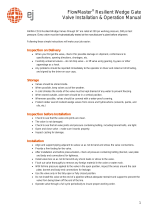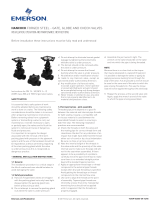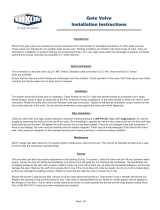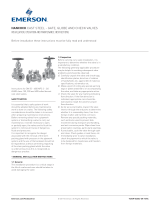
AMERICAN Flow Control
Series 2500 Resilient Wedge Gate Valve
Page 3A-44
SERIES 2500 - OPERATION & MAINTENANCE
Operation Spare Parts
Direction of opening is normally indicated by an
arrow cast on the handwheel or wrench nut of the
valve.
Operate gate valves from full closed to full open
position and back before applying pressure.
Close gate valve slowly against pressure to avoid
damage from surge or water hammer.
Valves installed on liquid service subject to
freezing conditions should be protected to prevent
trapping of liquid in the bonnet cavity, expansion
on freezing and subsequent damage. The same
is true of valves that are subject to considerable
temperature increases. Trapped pressure should
be vented back to the upstream side to prevent
buildup of pressure in the valve bonnet due to
high temperature expansion.
Valves should be opened and closed without the
use of excessive torque applied to the handwheel
or wrench nut. Excessive torque may damage the
valve.
Gate valves are designed for open and close
service. Their multi-turn design is not intended for
throttling. As such, the valve should never be left
in a partial open or closed position for extended
periods.
1.
2.
3.
4.
5.
6.
1.
2.
3.
Maintenance
Operate valves at regular intervals. The
necessary length of time between the operation
of the valve depends upon the time the valve has
been in service and the service conditions, but
more specically whatever time period is found
to be satisfactory based on local experience.
Operation should occur as a minimum of once per
year, but in general as detailed in Section A.6, of
Appendix A, of ANSI/AWWA C515.
Should disassembly or operation require
additional lubrication, use an AMERICAN Flow
Control recommended food grade grease for the
stem threads and thrust collar.
Chipped spots in the epoxy coating should be
repaired with a liquid two-part epoxy.
Undermostconditions,theonlysparepartsneededfor
thevalvewouldbeupperandlowerstemO-rings.Under
rigorous service, stems, wedges, upper and lower stem
O-rings and thrust washers should be carried as spare
parts.
Use parts list drawings as a guide for disassembly and
ordering repair parts. Also refer to disassembly/reassem-
bly instructions.
Typical Operating Torque At
Rated Working Pressure
Valve Size
Closing Torque
Ft-lbs
Opening Torque
Ft-lbs
2” 15-20 15-20
2-1/2” 15-20 15-20
3” 30-40 30-40
4” 30-40 30-40
6” 50-60 50-80
8” 70-80 60-90
10” 90-100 125-150
12” 100-125 140-175
14” Contact Factory
16” Contact Factory
18” Contact Factory
20” Contact Factory
24” Contact Factory
30” Contact Factory
36” Contact Factory
42” Contact Factory
48” Contact Factory
54” Contact Factory
60” Contact Factory
66” Contact Factory
WARNING: Special care should be taken in the installation, inspection and repair of pressure containing
devices such as valves and hydrants. FAILURE TO FOLLOW PROPER PRACTICE AND GUIDELINES CAN RESULT IN
SERIOUS INJURY OR DEATH. Do not make repairs while valve is under pressure.

AMERICAN Flow Control
Series 2500 Resilient Wedge Gate Valve
Page 3A-45
SERIES 2500 - TROUBLESHOOTING GUIDE
Number of Turns to Open/Close
Series 2500 / Series 2500-1
2” 2-1/2” 3” 4” 6” 8” 10” 12” 14” 16” 18” 20” 24” 30” 36” 42” 48” 54” 60” 66”
9 11 13 14 20 26 32 38 44 50 56 62 76 379 448 694 789 789 984 984
Note:24”andsmallerreectnon-gearedvalves.30”andlargerreectgearedvalves
Problem Solution
Leakage
Valve is Hard to
Operate or Is
Inoperable
Valve Leaks
During Testing
Depending on the location of the leakage, the following should be examined.
SEAT: Foreign material may be stuck under the valve wedge. Open valve only enough
to get high velocity ow to ush out valve. Repeat several times until leak stops. If this
does not solve the problem, it is then necessary to open the valve and check for damage
to the rubber encapsulated wedge. If it is damaged or severely cut, replace the wedge.
STEM: The stem seals are of the O-ring type and the valve has a thrust collar
(electric actuated valves normally do not have thrust collars). Always relieve pres-
sure before working on any valve. Check all O-ring seals for leakage and replace
as necessary. On OS&Y valves leakage can be stopped by evenly tightening the
packing gland bolts. If leakage cannot be stopped, the valve should be repacked.
BODY: Check for cracked or damaged valve body or bonnet. If damage has occurred,
contact manufacturer for further instructions.
BOLTED CONNECTIONS: Check for loose bonnet-to-body bolts, stung box bolts or
end joint bolts and tighten as necessary. This should be done prior to
pressurization of the line. If line is pressurized, pressure should be relieved
prior to tightening any bolts. Do not tighten bolts past the yield strength of the bolt. Reinstall
all bolts and nuts and tighten alternately to 70-90 ft-lbs of torque.
1.
2.
3.
4.
1.
2.
1.
2.
3.
3.
A valve can become inoperable or hard to operate during testing of the pipeline. Prior to
relieving pipeline pressure, the valve should be opened to relieve any trapped pressure.
The application of excessive torque on a valve can cause permanent damage to the
operating parts. A common source of excessive torque is from the use of portable
power actuators. Output torques generated by these machines should be adjusted to be
suitableforthevalvesize.Thelastorrstturnsofoperationshouldbedonebyhand.
If valve has not been operated periodically, excessive buildup could occur that
would aect valve operation. The valve should be exercised one turn at a time and
cycled from open to closed as necessary to attempt removal of internal buildup.
Resilient seated gate valves per ANSI/AWWA C515 have a zero allowable
leakage rate. If a leak is detected while testing, it is necessary to nd the cause.
If seat leakage is detected, it may be due to foreign material or trapped air in the line. Open the
valveenoughtogethighvelocityowtoushoutvalve.Repeatseveraltimesuntilleakage
stops.
Iftestingbetweenvalves,allowenoughtimetollthevalveandventoair.
/



